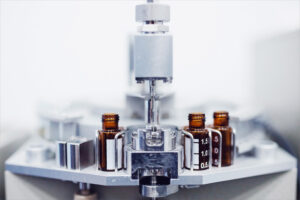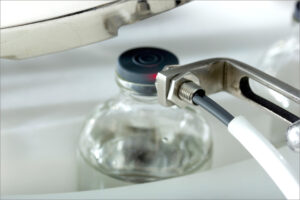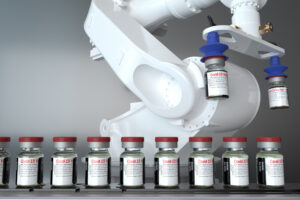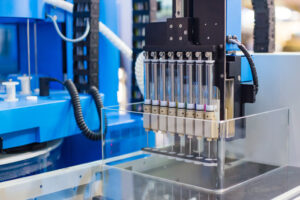Over the last half century or so, robotics have made their way into all forms of industry including packaging. Due to its highly regulated nature, one notable group that did not embrace the concept immediately in the early days was the pharmaceutical sector.
 Since then, the benefits to manufacturers, researchers, and scientists have become apparent making it worth the implementation and integration costs. Whether you are using cobots (lower-volume, high-mix production automating processes alongside human workers) or general robotics (somewhat larger, fixed equipment designed for higher-volumes, higher-speed manufacturing), you should see a return on your investment. With that said, the use of new and higher levels of automation in the pharmaceutical industry is reported to explode over the next 3-5 years.
Since then, the benefits to manufacturers, researchers, and scientists have become apparent making it worth the implementation and integration costs. Whether you are using cobots (lower-volume, high-mix production automating processes alongside human workers) or general robotics (somewhat larger, fixed equipment designed for higher-volumes, higher-speed manufacturing), you should see a return on your investment. With that said, the use of new and higher levels of automation in the pharmaceutical industry is reported to explode over the next 3-5 years.
Benefits, Challenges, and Long-term Changes
Initially when the pharma industry did use robots, they were often big, cumbersome, and required safety caging all around to protect the operator. Pharmaceutical companies have more recently caught on and are now learning the vast selection of benefits that robotic systems offer for many types of packaging – including liquid packaging: purging, filling, closing, capping, torquing, and labeling.
 One motivating factor had to do with the flexibility that robots can offer an increased level of automation with less human involvement. With the addition of robotics, quick changeovers are also an added and effective benefit while the removal of operators leads to greater efficiencies: fill accuracies, reduced errors, and less possibility of product contamination and operator injury.
One motivating factor had to do with the flexibility that robots can offer an increased level of automation with less human involvement. With the addition of robotics, quick changeovers are also an added and effective benefit while the removal of operators leads to greater efficiencies: fill accuracies, reduced errors, and less possibility of product contamination and operator injury.
In some instances where fully robotic systems have not been employed companies have made use of cobots or combined robot and human operated methods. This would seem to serve more as a transitional function; however, as we consider the question, ‘do robots eliminate human jobs?’ In one professional’s opinion, the answer is an emphatic “No” as robots often help to create new and complementary jobs. Simply put people are still needed to initially setup, perform maintenance, and generally operate the robots. Reallocation of skillsets and additional training then creates new employee opportunities with increased attraction to the labor force or those manufacturers implementing these new technologies and opportunities. However, there will always be new and emerging challenges along the way for companies wishing to increase robotic use in their facilities, so understanding short-term and long-term objectives, as well as systematic coordination will play a big role in the overall success of these efforts.
In a pharmaceutical manufacturing environment, robots’ primary functions are in areas such as in-feeding of bottles and closures as well as placement of fitments and droppers on or near the container. A big benefit in liquid filling is their ability to provide dosing functions which adds to the overall reliability and integrity to one’s manufacturing process.

Increased advancements in robotic technology have led to even further enhancements in the use of end effectors, i.e. robotic hands. In this regard, robots have become more accurate, flexible, and reliable. The accuracy, consistency, and dexterity of robotics allows for a high mix of products to be processed efficiently, accurately, and safely.
Apart from manufacturing, different levels of robotic use have also had a big impact in the lab. Laboratory research is often a function involving many repetitive and tedious motions mostly performed by humans. However, a targeted level of automation is well suited for this type activity and moving of fluids in vials, test tubes, etc. and do so with an increased level of accuracy and consistency. This too leads to greater improvements in quality, efficiency, and the validity of test results.

Increasingly more are other forms of robotics and different levels of automation such as weigh systems and optical technologies. Optical technology can provide a 100% on-line visual quality inspection systems. These advancements in automated optical features can even include enhanced vision sensors for color imaging which in turn can allow for distinctions between the color of different bottle caps on your liquid filling system.
AI (artificial intelligence) has been making its way into many aspects of manufacturing in recent years; playing a significant role in how we use automation and robotics in packaging. Within the pharma industry, it is felt that AI is still best suited for larger volume productions and does not hold as much value in smaller or less volume production batches.
Recognizing the Global Landscape

In an increasingly competitive global marketplace, the use of robots or increased levels of automation has become a desirable solution for cost-effective and quality driven businesses – this holds true for the pharmaceutical industry as well. As previously mentioned, the use of robotics and different levels of automation in the pharmaceutical industry is reported to increase heavily over the next 3-5 years.
So, with the advent of more customized and personalized medication treatments which dictate many and varied offerings usually with precise target volume outputs, robots are key to operational efficiencies within modern day pharmaceutical manufacturing. Finally, whereas robots have become common in North America and European companies, Asian companies continue to rely heavily on physical labor. With that said, robotics and increased implementation of robotic use can offer significant competitive advantages in different markets and regions when needed.
Bottom-line, industrial robots are increasingly becoming more ‘intelligent’, versatile, and cost-effective alternatives within manufacturing environments. For the bulk of society this comes as little surprise as we see these new levels of automation and robotic use in our everyday lives: household appliances, elements within new automobiles, the way we shop, ship, and receive things, and even now when ordering food and beverages. In the future, these technologies are expected to become even more capable of working without constant human intervention and helping to perform most of the manufacturing processes.
Specialists in Liquid Filling Systems

For over 70 years, FILAMATIC has been providing the widest range of liquid filling equipment while delivering the lowest cost of ownership to our customers. We excel in flexible, customized solutions for every stage of your business growth. Whether you require a single handheld filling machine, a complete turnkey fill-cap-label solution, or a fully automated, integrated Monobloc system, we have the experience to ensure your satisfaction is exceeded.
Following our core values – Ethical, Trust & Respect, Team-Oriented, Continuous Improvement, Adhere to the ‘Golden Rule’, Excellence, Customer-centric, and including Health, Safety, and the Environment (HSE) – FILAMATIC truly believes in the customer experience before, during, and after-the-sale. We believe in our unique performance, undeniable quality, and unrivaled support. For more information on liquid filling, capping, and labeling solutions, please call 866.258.1914 or email info@filamatic.com.
